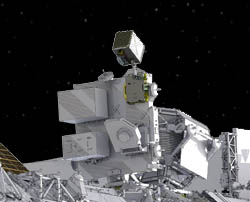The Neutron Star Interior Composition Explorer MissionNICER regains substantial daytime observing capabilityIn May 2023, NICER developed a "light leak" that allowed unwanted sunlight to enter the instrument during orbit day. Damage to some of the telescope's thin thermal shields, which block sunlight but allow X-rays through to the detectors, prevented the detector readout system from accurately registering cosmic X-rays in sunlit conditions much of the time. Nighttime observations were unaffected. In January 2025, an ISS crew-member installed patches to cover the largest areas of damage during a spacewalk, substantially reducing the overall level of sunlight inside NICER. Although the remaining visible-light interference was higher than expected, the repair enabled development of a detector readout reconfiguration that has now been fully implemented. In combination with the patches, the reconfiguration has allowed NICER to return to collecting observations during more than 70% of station daytime. Nighttime observations are still preferred for target-Sun angles less than 85 degrees and whenever sensitivity to photon energies below 0.5 keV is needed. For additional details, see the NICER Light-leak Overview page.For more information about how this incident affects NICER data, please see the NICER Data Analysis Caveats page. Please see the NICER Significant Events page for a list of occurrences that may affect NICER data or observing configurations. Current Activity
NICER was launched aboard a SpaceX
Falcon 9 rocket on June 3, 2017 at 17:07 EDT (21:07 UTC)
The Neutron star Interior Composition Explorer (NICER) is an International Space Station (ISS) payload devoted to the study of neutron stars through soft X-ray timing. Neutron stars are unique environments in which all four fundamental forces of nature are simultaneously important. They squeeze more than 1.4 solar masses into a city-size volume, giving rise to the highest stable densities known anywhere. The nature of matter under these conditions is a decades-old unsolved problem, one most directly addressed with measurements of the masses and, especially, radii of neutron stars to high precision (i.e., better than 10 percent uncertainty). With few such constraints forthcoming from observations, theory has advanced a host of models to describe the physics governing neutron star interiors; these models can be tested with astrophysical observations. NICER enables rotation-resolved spectroscopy of the thermal and non-thermal emissions of neutron stars in the soft (0.2-12 keV) X-ray band with unprecedented sensitivity, probing interior structure, the origins of dynamic phenomena, and the mechanisms that underlie the most powerful cosmic particle accelerators known. The NICER mission achieves these goals by deploying an X-ray timing and spectroscopy instrument on the International Space Station (ISS). By answering a long-standing astrophysics question - How big is a neutron star? - NICER confronts nuclear physics theory with unique measurements, exploring the exotic states of matter within neutron stars through rotation-resolved X-ray spectroscopy. The capabilities that NICER brings to this investigation are unique: simultaneous fast timing and spectroscopy, with low background and high throughput. NICER also provides continuity in X-ray-timing astrophysics more broadly, post-Rossi X-ray Timing Explorer, through a Guest Observer program. Finally, in addition to its science goals, NICER enables the first space demonstration of pulsar-based navigation of spacecraft, through the Station Explorer for X-ray Timing and Navigation Technology (SEXTANT) enhancement to the mission, funded by the NASA Space Technology Mission Directorate's Game-Changing Development program. NICER's X-ray Timing Instrument (XTI) represents an innovative configuration of high-heritage components. The heart of the instrument is an aligned collection of 56 X-ray "concentrator" optics (XRC) and silicon drift detector (SDD) pairs. Each XRC collects X-rays over a large geometric area from a roughly 30 arcmin2 region of the sky and focuses them onto a small SDD. The SDD detects individual photons, recording their energies with good (few percent) spectral resolution and their detection times to an unprecedented 100 nanoseconds RMS relative to Universal Time. Together, this assemblage provides a high signal-to-noise-ratio photon-counting capability within the 0.2-12 keV X-ray band, perfectly matched to the typical spectra of neutron stars as well as a broad collection of other astrophysical sources. From NICER's ISS platform, a star-tracker-based pointing system allows the XTI to point to and track celestial targets over nearly a full hemisphere. The pointing system design accommodates the ISS vibration and contamination environments, and enables (together with NICER's GPS-based absolute timing) high-precision pulsar light-curve measurements through ultra-deep exposures spanning the 18-month mission lifetime. Simulated NICER count rates and spectra can be derived using the WebPIMMS and WebSPEC tools. The Viewing tool can be used to determine the times when a specific sky position is potentially visible to NICER. More details are available in NICER's Mission Guide. An overview of NICER science is available here. More NICER documentation and publications. If you would like to receive email about NICER developments, please send an e-mail to nicer-announce-owner@lists.nasa.gov to subscribe to the NICER email announcements list. If you have scientist-related questions concerning NICER, such as calibration, analysis, proposing, ToOs, or coordination please
use HEASARC's Feedback form
, or click
the "HELP" icon to the left. For those interested in general astronomy/astrophysics information please go onward to the Education and Public Outreach site.
Latest News
|





